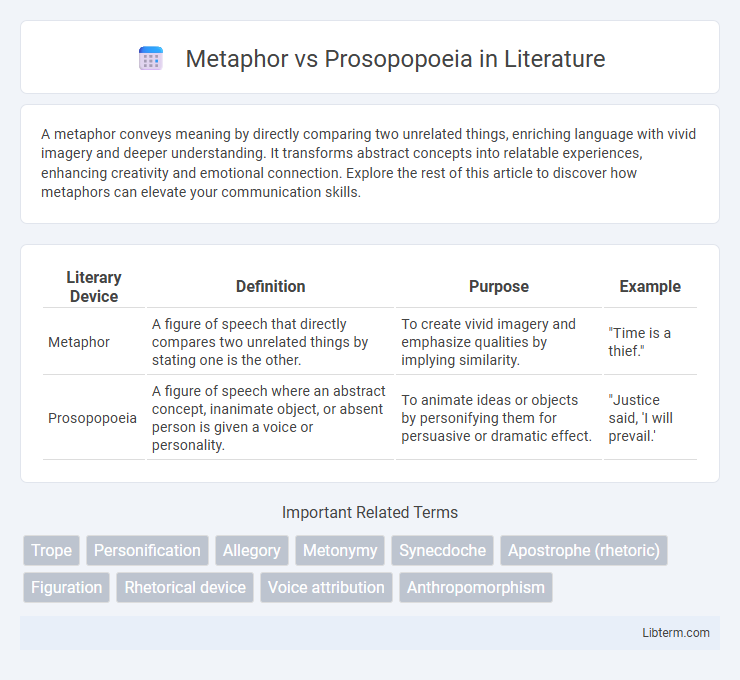A metaphor conveys meaning by directly comparing two unrelated things, enriching language with vivid imagery and deeper understanding. It transforms abstract concepts into relatable experiences, enhancing creativity and emotional connection. Explore the rest of this article to discover how metaphors can elevate your communication skills.
Table of Comparison
| Literary Device | Definition | Purpose | Example |
|---|---|---|---|
| Metaphor | A figure of speech that directly compares two unrelated things by stating one is the other. | To create vivid imagery and emphasize qualities by implying similarity. | "Time is a thief." |
| Prosopopoeia | A figure of speech where an abstract concept, inanimate object, or absent person is given a voice or personality. | To animate ideas or objects by personifying them for persuasive or dramatic effect. | "Justice said, 'I will prevail.' |
Understanding Metaphor: Definition and Essence
Metaphor is a fundamental figure of speech where a word or phrase is applied to an object or action to which it is not literally applicable, creating a direct comparison that enriches meaning. It conveys complex ideas through symbolic representation, enhancing understanding by linking unrelated concepts based on shared qualities. Unlike prosopopoeia, which gives voice to inanimate objects or abstract ideas, metaphor emphasizes imaginative equivalence rather than personification.
Prosopopoeia Explained: Giving Voice to the Inanimate
Prosopopoeia is a rhetorical device where inanimate objects, abstract concepts, or absent individuals are given voice to express thoughts or emotions, enhancing narrative engagement. Unlike metaphor, which draws symbolic comparisons between unrelated entities, prosopopoeia personifies entities by allowing them to speak or act, creating vivid imagery and deep emotional resonance. This technique is commonly used in literature and speeches to animate the inanimate and convey complex ideas through personalized expression.
Historical Origins of Metaphor and Prosopopoeia
Metaphor originated in ancient Greek rhetoric and philosophy as a fundamental literary device used by figures like Aristotle, who analyzed its role in effective communication and persuasion. Prosopopoeia also has roots in classical antiquity, particularly in Roman and Greek traditions, where it involved personifying abstract concepts or inanimate objects to convey emotion or argument more vividly. Both devices evolved through classical literature to remain central to the study of figurative language and its power in shaping narrative and argument.
Key Differences: Metaphor vs Prosopopoeia
Metaphor is a figure of speech that directly compares two unrelated things by stating one is the other, enhancing meaning through symbolic substitution. Prosopopoeia involves giving voice to an abstract concept, inanimate object, or absent person, effectively personifying it through speech or action. The key difference lies in metaphor's focus on symbolic equivalence, while prosopopoeia emphasizes dramatized personification and vocal representation.
Functions in Literature: How Writers Use Metaphor
Metaphor functions in literature by allowing writers to create vivid imagery and convey complex ideas through indirect comparison, enriching the reader's experience and deepening thematic resonance. It enables authors to express emotions and abstract concepts in a tangible form, making the narrative more engaging and memorable. Prosopopoeia, by contrast, attributes human qualities or voices to inanimate objects or abstract concepts, often serving to animate and personalize elements within the text to provoke empathy or highlight significance.
The Power of Prosopopoeia in Storytelling
Prosopopoeia enhances storytelling by animating abstract concepts or inanimate objects through personification, creating vivid and emotionally engaging narratives that resonate deeply with audiences. Unlike metaphor, which draws implicit comparisons between disparate elements, prosopopoeia gives voice and agency to entities, fostering empathy and a more immersive experience. This rhetorical device elevates narratives by transforming static ideas into dynamic characters, thereby amplifying thematic impact and reader connection.
Analyzing Famous Examples of Metaphor
Metaphors vividly convey complex ideas by directly equating one thing with another, as seen in Shakespeare's "All the world's a stage," which encapsulates life's performative nature. Analyzing Emily Dickinson's "Hope is the thing with feathers" reveals how metaphors personify abstract concepts, enhancing emotional resonance and imagery. These famous metaphors demonstrate how figurative language enriches literary meaning by creating powerful, imaginative connections between disparate elements.
Prosopopoeia in Classic and Modern Texts
Prosopopoeia, a rhetorical device where inanimate objects, abstract concepts, or absent persons are given human qualities or voices, plays a pivotal role in both classical and modern literature by creating vivid personifications that enhance emotional resonance. In classical texts, such as those by Cicero and Quintilian, prosopopoeia was employed to animate virtues, vices, or natural forces, elevating rhetorical impact and moral appeal. Modern literature continues this tradition, using prosopopoeia to explore psychological depth and social critique, often blending it with metaphor to produce layered meanings and introspective narratives.
Impact on Reader Interpretation and Engagement
Metaphor enriches reader interpretation by creating vivid mental images that link familiar concepts to abstract ideas, deepening understanding and emotional resonance. Prosopopoeia enhances engagement by personifying inanimate objects or abstract concepts, giving them a voice that invites readers to explore multiple perspectives and evokes empathy. Both literary devices stimulate imagination but differ in their approach, with metaphor relying on symbolic comparison and prosopopoeia on direct anthropomorphic expression.
Choosing the Right Device: When to Use Metaphor or Prosopopoeia
Metaphor effectively conveys abstract ideas by directly comparing two unrelated concepts, making complex emotions or themes more relatable and vivid. Prosopopoeia, a form of personification where inanimate objects or abstract concepts speak or act, is ideal for giving voice to ideas, enhancing engagement by animating non-human elements. Choose metaphor for succinct, imaginative comparison, and prosopopoeia when you want to dramatize or animate an idea for emotional impact and narrative depth.
Metaphor Infographic

 libterm.com
libterm.com